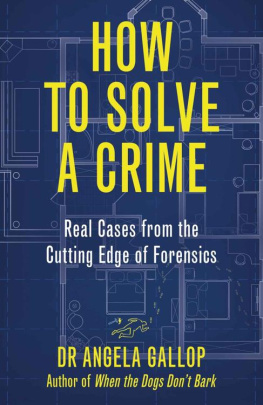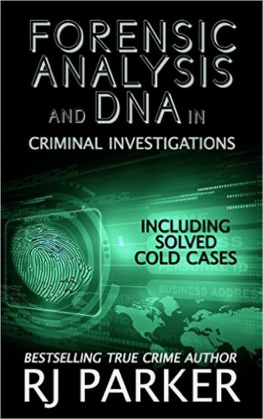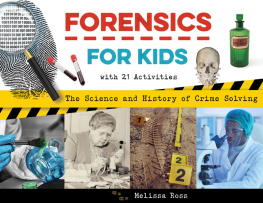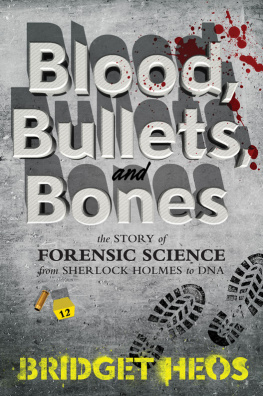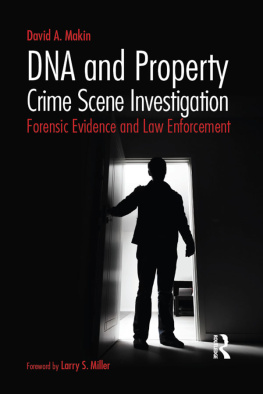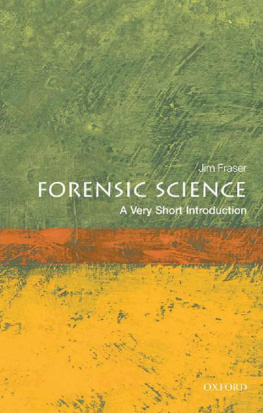Also by Angela Gallop
When the Dogs Dont Bark:
A Forensic Scientists Search for the Truth
How to Solve a Crime
Real Cases from the Cutting
Edge of Forensics
Dr Angela Gallop
With Jane Smith

www.hodder.co.uk
First published in Great Britain in 2022 by Hodder & Stoughton
An Hachette UK company
Copyright Angela Gallop and Jane Smith 2022
The right of Angela Gallop and Jane Smith 2022 to be identified as the Author of the Work has been asserted by them in accordance with the Copyright, Designs and Patents Act 1988.
Cover design by Natalie Chen | Cover images Shutterstock.com
All rights reserved. No part of this publication may be reproduced, stored in a retrieval system, or transmitted, in any form or by any means without the prior written permission of the publisher, nor be otherwise circulated in any form of binding or cover other than that in which it is published and without a similar condition being imposed on the subsequent purchaser.
A CIP catalogue record for this title is available from the British Library
eBook ISBN 9781529331363
Hardback ISBN 9781529331349
Trade Paperback ISBN 9781529331356
Hodder & Stoughton Ltd
Carmelite House
50 Victoria Embankment
London EC4Y 0DZ
www.hodder.co.uk
Look out for linked text (which is in blue) throughout the ebook that you can select to help you navigate between notes and main text.
You can double tap images to increase their size. To return to the original view, just tap the cross in the top left-hand corner of the screen.
To the many scientists and other professionals Ive worked with originally in the Forensic Science Service, and then in Forensic Access, Forensic Alliance/LGC Forensics, and latterly Axiom International and who have taught me so many interesting things and elevated my own endeavours to whole new levels. I am immensely grateful to you all.
Acknowledgements
I would like to acknowledge all of the people who have contributed to this book in one way or another, all whom I have admired and many of whom I have personally worked with over the years. They include in particular:
Dr Samantha Pickles
Dr Alex Allan
Professor Sue Black
Dr Marjorie Turner
Ed Jarman
Dr Itiel Dror
Peter Swann
Dr Clive Candy
Dr Mike Jenkins
Nigel Kelly
April Robson
Dr Philip Avenell
Deb Hopwood
Dr Ian Evett
Caroline Crawford
Dr Richard Shepherd
David Martin
The Links Group
Dr Anthony Peabody
Huw Griffiths
Geoff Arnold
Roy Green
Stephen Cole
Damian Walton
Dr Chris Davies
Professor Peter French
Russell Stockdale
Denise Stanworth
Professor Robert Forrest
Professor Roger Robson
Chris Gregg QPM
Professor Patricia Wiltshire
Professor Gisli Gudjonsson
Contents
Introduction
A man runs down a dark alleyway, the sound of his footsteps echoing from the damp stone walls. As the camera pans in, we can see blood on his hands and on the front of his hooded jacket. Most of his face is hidden. But as he emerges from the shadows on to the dimly lit street he turns his head, and we catch a glimpse of what appear to be three scratch marks on his left cheek.
Cut to a forensic laboratory, where a scientist has just matched the sole of a trainer seized from a suspects flat with the bloody footwear marks she had lifted earlier that morning from the floor of the kitchen where the terrible crime took place. If I can get a DNA sample from the scrapings taken from under the victims fingernails, she says, focusing the microscope with her own slender fingers, we might be able to identify the murderer before the end of the day.
Typical scenes, perhaps, from one of the many fictionalised versions of forensic science that feature in some entertaining programmes on TV. But I think that real forensics is much more interesting and I hope that, after reading this book, youll tend to agree.
My first book, When the Dogs Dont Bark , told the story of my professional career, initially as a forensic biologist with the Home Office Forensic Science Service, and then as a founder or co-founder of forensic companies, when I also specialised particularly in cold-case investigations.
During those years, I have been privileged to work with some of the most talented and inspirational forensic scientists in the UK. And How to Solve a Crime considers a much broader range of forensic expertise as I have tried to tell aspects of their stories, mixed with my own experiences, in an effort to present forensic science in its true light.
Because forensics can involve anything and everything encountered in everyday life, attempting to cover every aspect of it would be a very tall order. So I have tried instead to give a flavour of its richness and variety, and to counteract the notion that it is all about crime scene investigation (CSI). Its true that the crime scene is where most forensic science begins. But although CSI is certainly very important, it generally constitutes only part of the job of a forensic scientist.
The next stage in the process takes place in the laboratory, where items and samples from the crime scene and elsewhere are examined and tested, and the results are evaluated in the context of the specific circumstances of the case in hand. This, in turn, usually leads to the courtroom, where these results are presented as evidence for the judge and jury to consider.
While writing this book, I was aware that it mustnt end up being less about how to solve than how to get away with crime! Another thought that kept coming to the forefront of my mind was that there are two main things preventing us today from being able to solve virtually every crime. The first is error due to inexperience or lack of appropriate forensic skills. The second is the lack of sufficient funds being spent on collecting and investigating the evidence that is there somewhere, just waiting to be found.
Smash and grab forensics is no way to get to the bottom of a really complex case. Rather, it requires a combination of innovative approaches, laser-like observation, and testing carried out with surgical precision by dedicated and experienced forensic scientists to help to identify and convict the guilty and exonerate the innocent. Indeed, the contribution forensic science can make to the delivery of justice would be beyond the wildest imaginings of French criminologist Edmond Locard when he developed his principle of every contact leaves a trace more than a hundred years ago. But he was spot on, as we have been able to prove time and time again.
Another reality that might not be apparent from watching TV programmes is that forensic scientists often dont know the outcomes of the cases they work on. This is because some of the many cases we deal with dont go to court until months, even years later, and we are not always called to give evidence when they do. Also, for someone to be convicted of a crime, it is usually necessary to have more than one type of evidence to link them with it. But I hope that the cases and details I have included at least give an idea of what forensic scientists actually do, and why they find the work so satisfying... most of the time.
I am very grateful to all the friends and colleagues (listed in the Acknowledgements) who shared their knowledge and experiences and who provided details of some of the case studies included.
Angela Gallop CBE, 2022
What insects can tell us about crime
One day, the fully clothed body of a farmer was found at the side of a road. The numerous wounds on his head appeared to have been inflicted with a sickle, and it was thought at first that he had been killed during the course of a robbery. But when it became apparent that no personal effects were missing from the body, the farmers wife was questioned about any possible enemies he might have had. Although there were none that she could think of, she did give the investigator the name of a man who had recently asked to borrow money from her husband, but didnt get it.
Next page
